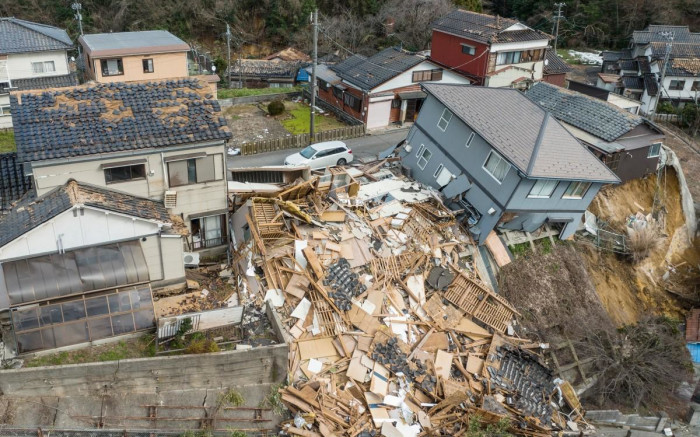
The elderly woman spent five days under the rubble of a collapsed house in the city of Suzu before being rescued on Saturday. She was reportedly taken to the hospital for treatment and responded clearly to questions.
This aerial photo shows damaged and destroyed houses along a street in Wajima, Ishikawa Prefecture, on January 2, 2024, a day after a massive 7.5-magnitude earthquake struck the Noto region of Ishikawa. (Photo by Fred MERY / AFP)
SUZU – A woman in her 90s trapped under rubble for five days during a massive earthquake in central Japan was rescued against all odds, but snow and storms were expected Sunday to complicate relief efforts.
At least 126 people died in the magnitude 7.5 earthquake on New Year’s Day and its aftershocks – a toll that is certain to rise, with 222 others reported missing to local authorities.
The tremor and its aftershocks collapsed buildings, started a major fire and triggered tsunami waves over a meter high.
The hope of finding survivors usually disappears three days after a devastating earthquake.
But the elderly woman spent five days under the rubble of a collapsed house in the city of Suzu before being rescued on Saturday.
According to public broadcaster NHK, she was taken to hospital for treatment and answered questions clearly.
“Hold on!” In police footage from the scene released by local media, rescue workers could be heard calling for the woman.
“You’ll be fine!” they screamed as the rain fell around them. “Stay positive!”
A Tokyo police spokesman confirmed to AFP that the rescue was carried out by officers from Tokyo and Fukuoka, but could not provide further details.
Many communities on the Noto Peninsula, where Monday’s quake struck, were cut off by damaged roads, with some of the estimated 1,000 landslides also blocking relief vehicles.
Cold rain was forecast to turn to snow by Sunday afternoon on the peninsula on the Sea of Japan side of the country’s main island, Honshu.
HELICOPTER MISSIONS
The bad weather threatened to further complicate the demanding rescue mission of thousands of police officers, soldiers and other rescue workers.
In addition, conditions for more than 30,000 people in 366 government shelters as of Saturday could worsen as relief supplies are slow to reach areas experiencing water and power outages.
“The first priority was to rescue people under the rubble and reach isolated communities,” Prime Minister Fumio Kishida said in an interview with NHK on Sunday.
The military has sent small groups of troops on foot into each of the isolated communities, he said.
The government has also deployed “various police and fire helicopters to reach them from the air,” Kishida added.
“In parallel with these efforts, we must improve the conditions in the shelters and the health of the victims of the disaster,” as they may have to stay in place for a long time, he warned.
In the city of Anamizu, rescuers wearing heavy-duty orange or blue rain suits were seen carrying the body of a landslide victim, covered with a blue tarp, under a fallen pole.
And amid widespread destruction in the town of Wajima, a shrine’s traditional red gate remained standing, but the view through the gate was a now-familiar mess of splintered wood and fallen beams.
Japan experiences hundreds of earthquakes every year, most of which cause no damage because of strict building regulations that have been in place for more than four decades.
But many buildings are older, especially in rapidly aging communities in rural areas like Noto.
The country is hit by the devastating 2011 earthquake, which triggered a tsunami, left around 18,500 people dead or missing and caused a nuclear disaster at the Fukushima nuclear power plant.






Recent Comments